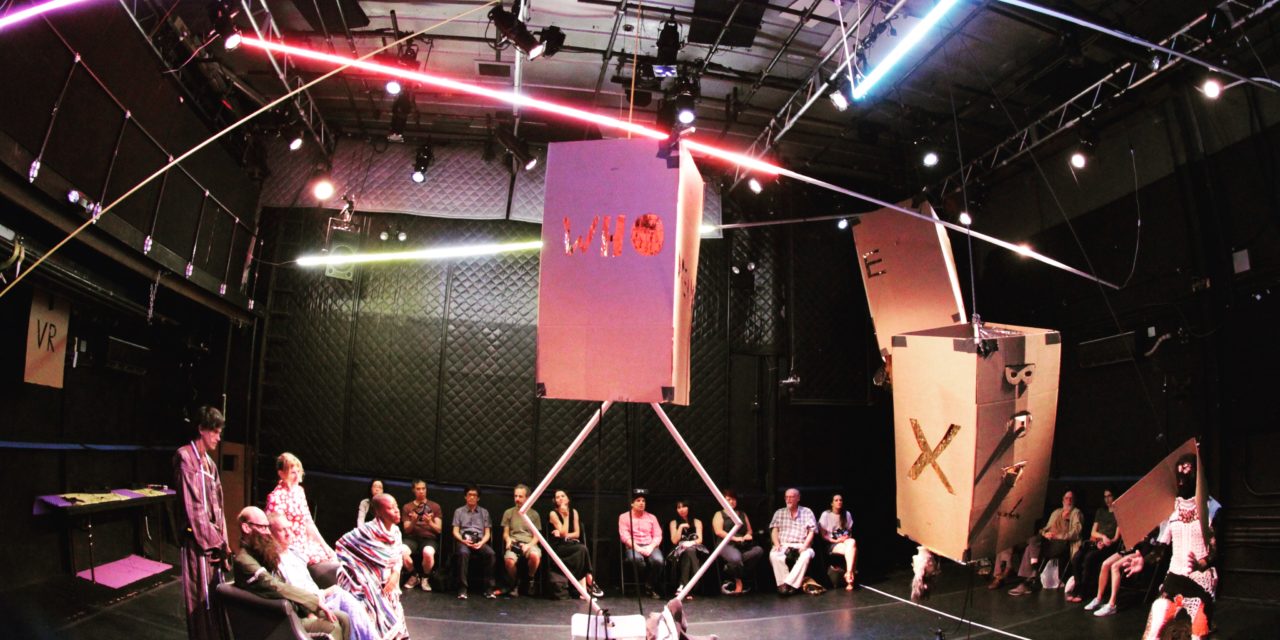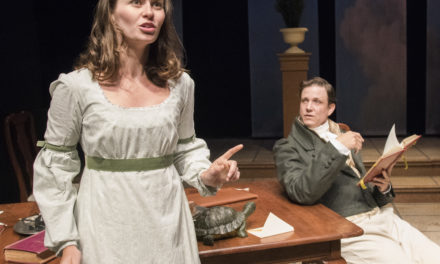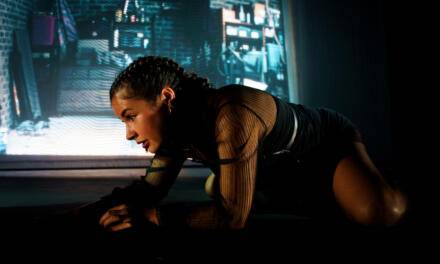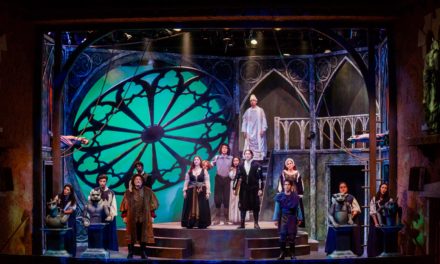Soho’s Performing Garage is the setting of a brief engagement from Poland called Białoszewski/Ginsberg VR. A collaboration between Warsaw’s famed Nowy Teatr and the imaginatively titled Dream Adoption Society, Białoszewski is an hourlong experimental production that features audience members seated on the edge of the stage, all of whom are offered virtual reality goggles at several points in the evening.
Białoszewski begins with the audience in darkness as a male narrator recites what appears to be letters by the titular Allen Ginsberg to his fellow Beatnik and muse Neal Cassady. The auditorium remains dark for several minutes as Ginsberg recounts a story to Cassady, a device which is oddly comforting in its unconventionality. The lights are subsequently raised onto a stage with several cardboard boxes suspended from the ceiling. The boxes, resembling moving boxes, comprise the crux of the scenic design and are embossed with seemingly random words as well as pieces of copper-colored foil.
The spare but effective set design features a curved sofa which is astutely utilized to seat several actors, at one point crowded together in a humorously unsettling manner. The lighting is likewise stark and flat, the better to evoke a sense of disorientation that is the prevalent tone of the evening. The text seems to evoke the non-linear nature of the titular writers, American Allen Ginsberg and Polish actor and writer Miron Białoszewski.
Both men were alive and active at approximately the same time during the mid-to-late 20th century. While Ginsberg is the more famous figure in the US, the production offers an opportunity for the audience at New York’s Performing Garage to become better acquainted with an influential Polish writer and performer whose biography renders him an influential literary figure worthy of wider exposure. His life and work likewise seem to parallel that of Ginsberg, both literary outsiders who lived a counterculture existence during the political and cultural renaissance that was the 1960s and 1970s.
The cast includes characters from the two men’s lives who seem to play either comforting or disturbing roles from their biography. At one point busts adorned with wigs are hoisted from beneath the cardboard boxes in a menacing manner. The VR goggles feature surrealistic images of various locations from a bird’s eye view. The integration of this evocative imagery helps expand the visual palette of the stage and effectively suggests the otherworldly nature of the writers’ work.
The evening’s chief strength is its ability to create a mood of mystery and disorientation with a spare palette of boxes, minimal lighting, a sofa, and little else. The costumes are similarly spare but diverting, utilizing mostly muted tones and subtle patterns. Director Krzysztof Garbaczewski deserves credit for marshaling a solid cast of actors in various states of conflict, distress, and glee through a range of scenarios.
A familiarity with the two men’s work is beneficial yet not essential to a comprehensive understanding of the esoteric nature of the clever, elliptical text. The production offers a range of pleasures, from a vertiginous employment of the Performing Garage’s compact stage to the committed performances and the engaging virtual reality vistas. The sound design is likewise inventive, as noises are effectively utilized to help establish mood in the absence of more conventional scenic design. In fact, Białoszewski studiously eschews convention at every opportunity, whether it be the linear narrative, normative behavior, or conventional design and sound.
That the production offers instead an evening that is ultimately rewarding on its own idiosyncratic terms is a testament to the consistent dedication of the cast and creative team.
Białoszewski/Ginsberg VR was presented at the Performing Garage at 33 Wooster Street in New York City.
This post was written by the author in their personal capacity.The opinions expressed in this article are the author’s own and do not reflect the view of The Theatre Times, their staff or collaborators.
This post was written by Jack Wernick.
The views expressed here belong to the author and do not necessarily reflect our views and opinions.


















